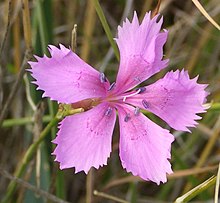| Caryophyllales | |
|---|---|

| |
| Dianthus caryophyllus | |
| Scientific classification | |
| Kingdom: | Plantae |
| Clade: | Tracheophytes |
| Clade: | Angiosperms |
| Clade: | Eudicots |
| Clade: | Superasterids |
| Order: | Caryophyllales Juss. ex Bercht. & J.Presl[1] |
| Suborders | |
| Synonyms | |
Caryophyllales (/ˌkæri.oʊfɪˈleɪliːz/ KARR-ee-oh-fih-LAY-leez)[2] is a diverse and heterogeneous order of flowering plants that includes the cacti, carnations, amaranths, ice plants, beets, and many carnivorous plants. Many members are succulent, having fleshy stems or leaves. The betalain pigments are unique in plants of this order and occur in all its core families with the exception of Caryophyllaceae and Molluginaceae.[3] Noncore families, such as Nepenthaceae, instead produce anthocyanins.[4]
In its modern definition, the order encompasses a whole new group of families (formerly included in the order Polygonales) that never synthesize betalains, among which several families are carnivorous (like Nepenthaceae and Droseraceae).
According to molecular clock calculations, the lineage that led to Caryophyllales split from other plants about 111 million years ago.[5]
- ^ Angiosperm Phylogeny Group (2009). "An update of the Angiosperm Phylogeny Group classification for the orders and families of flowering plants: APG III". Botanical Journal of the Linnean Society. 161 (2): 105–121. doi:10.1111/j.1095-8339.2009.00996.x. hdl:10654/18083.
- ^ Clarke, Ian; Lee, Helen (2003). Name that Flower: The Identification of Flowering Plants. Melbourne University Publishing. p. 56. ISBN 978-0-522-85060-4.
- ^ Kubitzki, Klaus; Bayer, Clemens; Cuénoud, Philippe (January 2003). Flowering Plants · Dicotyledons: Malvales, Capparales and Non-betalain Caryophyllales. Springer. pp. 1–4. ISBN 978-3-642-07680-0.
- ^ Dávila-Lara, Alberto (2021). "Proof of anthocyanins in the carnivorous plant genus Nepenthes". FEBS Open Bio. 11 (9): 2576–2585. doi:10.1002/2211-5463.13255. PMC 8409308. PMID 34289256.
- ^ Susana Magallón & Amanda Castillo (2009), "Angiosperm diversification through time", American Journal of Botany, 96 (1): 349–365, doi:10.3732/ajb.0800060, PMID 21628193